Low-Shedding Dog Breeds
If you want a canine bestie and a cleaner home — yes, you can have it all — check out these breeds.
If you want a canine bestie and a cleaner home — yes, you can have it all — check out these breeds.
by Jackie Brown, | April 23, 2025

Julie Meme / Stocksy
Pet lovers who suffer from dog allergies, or those who prefer a cleaner home without hair all over, can find a great match with one of the wonderful dog breeds who shed less. Low-shedding dog breeds come in all sizes, with different energy levels and temperaments, from large, athletic breeds to small lap dogs.
These dogs may be somewhat hypoallergenic. However, no dog is 100 percent allergen-free — not even low-shedding dog breeds. Before adopting a low-shedding dog, spend time with the individual dog in question to make sure you don’t react to them.
TL;DR: Low-shedding dog breeds help reduce pet hair around the home. Breeds such as Poodles, Maltese, and Bichon Frises have somewhat hypoallergenic coats and shed very little. These dogs are perfect for neat-freak pet parents or those with minor allergies looking for a friendly companion.
Some breeds are naturally low-shedding, with any shed hairs usually caught in the coat, which is why brushing is essential to prevent matting and tangles with these breeds. Here are some key traits about low-shedding dog breeds.
Medium to long coats: Some low-shedding breeds have curly hair like a Poodle or Bichon Frise. Others have straight, silky hair like a Maltese or Yorkshire Terrier. Some terriers, such as the Miniature Schnauzer, have wiry coats that shed very little.
Higher grooming needs: Most low-shedding dogs need more grooming than short-haired, wash-and-wear breeds. If you want a low-shedding breed, plan for frequent brushing and budget for regular professional grooming.
Haircuts are needed, too: The hair of low-shedding dog breeds usually has a longer growth cycle than other dogs. Instead of falling out quickly and being replaced by new hairs, it grows continuously like human hair, so they need haircuts.
Easier cleanup: The trade-off for this extra grooming is no dog hair in the house, something that’s usually appealing for people with minor allergies and those who prefer less vacuuming.
Make use of accessories: To cut down on brushing time, you can keep a low-shedding dog in a short, easy-to-maintain pet clip.
Although these breeds are low-shedding, no dog is completely non-shedding. Mixes of these breeds, which are often found in shelters and rescues, might or might not be low-shedding. Their shedding level depends on their breed parentage and their genetic makeup. Here’s a list of 10 dog breeds who shed the least.

ozgurcankaya / iStock
The hypoallergenic Poodle is the ultimate low-shedding dog breed. The curly coat doesn’t shed and has a soft, luxurious feel. If you don’t want to do too much brushing, ask the groomer for a short pet clip. The breed comes in three sizes, so there’s a Poodle for everyone. Toy Poodles and Miniature Poodles are small, so it’s easy to meet their exercise needs with a few walks a day. Standard Poodles range from medium-sized to large in size. These athletic dogs are great for active individuals and families who can provide them with longer walks, hikes, and free running. All Poodles are extremely smart, highly trainable, friendly, and affectionate.
Weight: 2 to 75 pounds
Height: 7 to 24 inches
Search for Poodles (and their mixes) for adoption

Eva / AdobeStock
One of the top small-dog breeds who don’t shed much, the tiny Maltese has a long, silky white coat that is easy to maintain when kept trimmed short. Maltese are lively, confident, intelligent dogs who love to be with their people. They are great dogs for apartment living, and small enough to take with you wherever you go. A short walk or two a day is all they need for exercise. Since Maltese are somewhat fragile, they do best with adults or families with kids older than five years of age. They tend to get along great with other pets, including cats.
Weight: 5 to 13 pounds
Height: 8 to 10 inches
Search for Malteses (and their mixes) for adoption

Matt Hunt / Stocksy
The Miniature Schnauzer has a wiry coat that doesn’t shed but needs professional grooming — either clipping or handstripping — to remove loose hairs while retaining the coat’s hard, wiry texture. Miniature Schnauzers are an energetic breed who needs lots of exercise, training, and engagement, or they might turn to barking or digging in the yard. They are quite smart and can be easily trained with the right motivation to overcome their stubborn streak. With enough physical and mental stimulation, Mini Schnauzers are engaging, affectionate companions.
Weight: 9 to 19 pounds
Height: 13 to 14 inches

LightField Studios/ Shutterstock
The fluffy, white Bichon Frise has a curly, non-shedding coat that’s very similar to that of the Poodle. It needs the same type of care: professional grooming and daily brushing, unless you choose to keep your Bichon in a short pet clip. This breed is highly intelligent and loves to please you. This dog can learn endless tricks and commands, and will love showing off their skills to anyone they meet. Lively yet calm, this breed is good for apartment living. One or two short walks a day will keep a Bichon happy and well-exercised.
Weight: 6 to 16 pounds
Height: 9 to 11 inches
Search for Bichon Frises (and their mixes) for adoption

Nicole Mlakar / Stocksy
The Shih Tzu has a long, silky coat that doesn’t shed much. Although a Shih Tzu in full coat needs daily brushing and combing, lots of Shih Tzu pet parents keep them clipped short for less maintenance. Shih Tzu are happy, charming little pets who have never met a stranger. They get along great with people of all ages, other dogs, and even cats. One or two short 30-minute walks a day are perfect for the little Shih Tzu. This is another low-shedding breed who does well in apartments and condos, because they don’t need a lot of space to be happy.
Weight: 10 to 21 pounds
Height: 10 to 11 inches
Search for Shih Tzus (and their mixes) for adoption

Craig Holmes / Stocksy
Yorkshire Terriers are low-maintenance, non-shedding dogs who fit into any living space (from apartments and condos to larger homes) and adapt well to life with individuals or families — as long as the kids are older than five and capable of treating these tiny dogs gently. These toy-sized terriers have a feisty side, but they typically live peacefully with other pets, including cats. Brush their long, silky hair daily, or keep it in a low-maintenance short clip.
Weight: 2 to 10 pounds
Height: 7 to 8 inches
Search for Yorkshire Terriers (and their mixes) for adoption

Jolanda Aalbers / Shutterstock
A low-shedding dog breed perfect for families, Havanese are delightful little dogs with long, silky, flowing coats. Though not traditionally trimmed, the Havanese can sport a shorter haircut if you don’t want to devote time to daily brushing and combing. Havanese are playful and outgoing, but they don’t need tons of exercise: a daily walk or two plus playtime in the yard is usually enough for most Havanese. This breed is easy to train and naturally wants to please you, so they tend to be well-behaved.
Weight: 7 to 16 pounds
Height: 8 to 11 inches
Search for Havanese (and their mixes) for adoption

Frank11 / Shutterstock
The Portuguese Water Dog tops the list of low-shedding dog breeds perfect for families who enjoy outdoor adventure. Portuguese Water Dogs are athletic and high-energy, so they need large amounts of exercise to be calm in the home. They love swimming, whether in a lake, pond, pool, or even the ocean. Their coat can be curly or wavy, and does not shed. Porties need professional grooming, but only weekly brushing in between grooming sessions. This breed is easy to train and thrives on abundant attention from their human family.
Weight: 33 to 66 pounds
Height: 17 to 22 inches
Search for Portuguese Water Dogs (and their mixes) for adoption

Vera Lair / Stocksy
The Chinese Crested is a partially hairless breed — naked on the body with puffs of soft, silky hair on the head, tail, and legs. There is also a fully coated variety, known as a “powderpuff,” who is covered in soft, silky hair. Both varieties are low-shedding and mostly hypoallergenic, but need daily brushing to prevent tangles. Chinese Crested dogs are very loving and affectionate with their human families, and enjoy snuggling and cuddling. Short daily walks and play sessions at home are sufficient exercise for these tiny dogs, who make great apartment dogs.
Weight: 7 to 16 pounds
Height: 9 to 13 inches
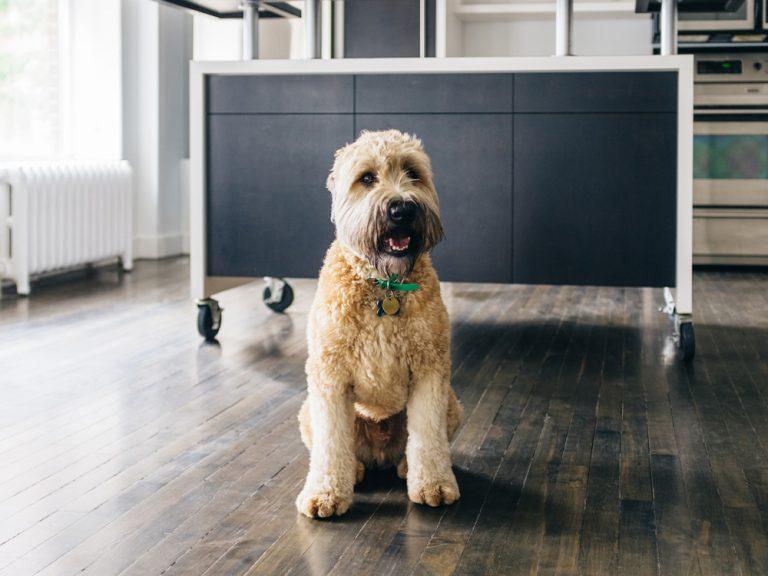
Jen Grantham / Stocksy
The Soft-Coated Wheaten Terrier is a medium-sized, sturdy terrier with a soft, low-shedding coat that requires significant upkeep — including professional grooming every six to eight weeks, and daily brushing and combing to prevent tangles and matting. These dogs have abundant energy and need vigorous daily exercise to feel and act their best. They can be a little strong-willed and challenging to train, so this breed might not be best for first-time pet parents.
Weight: 24 to 51 pounds
Height: 18 to 19 inches
Search for Soft-Coated Wheaten Terriers (and their mixes) for adoption
When choosing a low-shedding dog breed, look beyond their shedding status to assess if their size, personality, and exercise needs suit you. Most low-shedding dog breeds need plenty of grooming, typically a thorough brushing and combing daily or every other day, and professional grooming every six to 12 weeks. Hairless and partially hairless breeds also need special skin care, typically more frequent baths and sometimes lotion application.
Other considerations when choosing a low-shedding breed include the following.
Energy needs: Large or very energetic breeds need more exercise, from one to two hours a day. Smaller, lower-energy breeds are usually good with one or two 30-minute walks a day.
Temperament: Do you want a calm, cuddly breed, or do you prefer an active dog whom you can take with you on hikes or train for a dog sport?
Space requirements: If you live in a smaller apartment or condo, a small dog will fit right in, but small dogs are also happy in larger home environments. Large dogs do better in homes with a fenced-in yard to play in.
First-time pet parents: If this will be your first dog, look for a breed who tends to be eager to please and easy to train. Dogs who need a lot of training or behavioral management can be tough for first-time pet parents.
It’s generally easy to assess how much an adult dog sheds by petting them, holding them against your clothing, and brushing them to see how much hair comes out.
A dog breed is low-shedding when it has a certain type of hair that doesn’t fall out as frequently as certain breeds. Low-shedding dog breeds might have a curly coat like a Poodle, a straight coat like a Maltese, or a wiry coat like a Miniature Schnauzer. Low-shedding dog breeds still need brushing and sometimes professional grooming.
Low-shedding dog breeds are often considered somewhat hypoallergenic because they may spread less dander in the house. However, no dog is 100 percent hypoallergenic.
Many low-shedding dog breeds need daily brushing and combing, plus professional grooming every six to 12 weeks. This is especially true if a low-shedding dog has a long coat prone to matting or tangling. Keeping a low-shedding dog in a short clip cuts down on the frequency of brushing.
Low-shedding dogs are better for allergy sufferers because they shed less hair. With proper grooming, they may spread less dander, which is a common allergen. (Dander is also present in the skin, urine, and saliva, so sensitive individuals may not find allergy relief.) All people and dogs are unique, and not all people with dog allergies can live comfortably with even a low-shedding dog. Always spend time with any dog you’re may adopt to make sure you don’t react to them.
Small, low-shedding dog breeds are best for apartments. Some good choices include Toy and Miniature Poodles, Maltese, Yorkshire Terriers, Shih Tzu, Bichon Frises, and Chinese Crested dogs.
Packer, Rowena M. A., et al. “Come for the Looks, Stay for the Personality? A Mixed Methods Investigation of Reacquisition and Owner Recommendation of Bulldogs, French Bulldogs and Pugs.” PLoS One, vol. 15, no. 8, 26 Aug. 2020, journals.plos.org/plosone/article?id=10.1371/journal.pone.0237276, https://doi.org/10.1371/journal.pone.0237276.
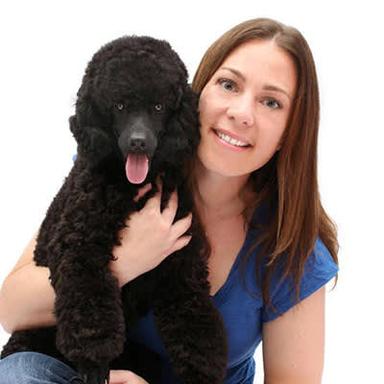
Jackie Brown lives in sunny Orange County, CA, where she works as a freelance writer and editor. When she’s not on deadline, you can find her paddling her outrigger canoe in the Pacific Ocean or hiking in the foothills with her miniature poodle and two young boys.
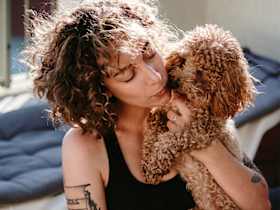
Breed Info

Breed Info
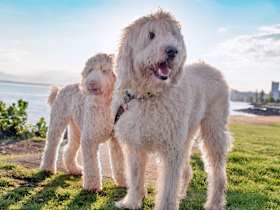
Breed Info
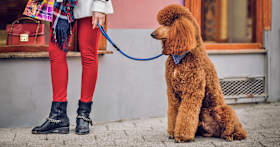
Breed Info
Is this smart, affectionate, but energetic breed right for you?
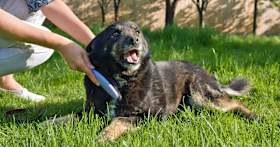
Adoption Advice
Aside from keeping your dog pretty or handsome, grooming is an important part of maintaining their health. Here are some tips on knowing when your pup needs a little freshening up.
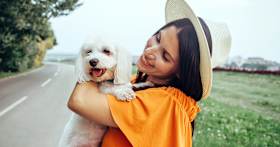
Breed Info
Yes, unicorn dogs do exist. Here are 10 breeds who require little grooming and exercise, but still offer lots of love.
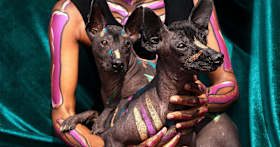
Breed Info
These pups may not have any fur, but they sure know how to rock it.
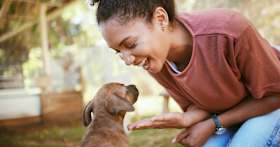
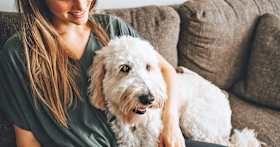
Breed Info
This Retriever-Poodle mix is affectionate and playful. But they also require more attention than you might think.